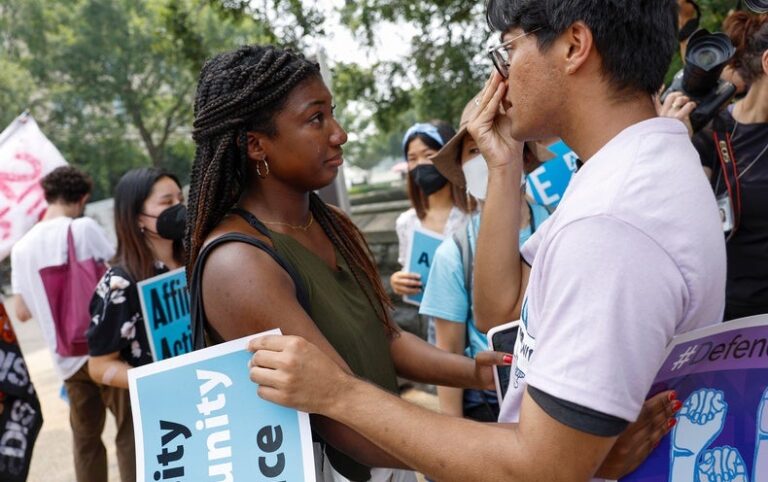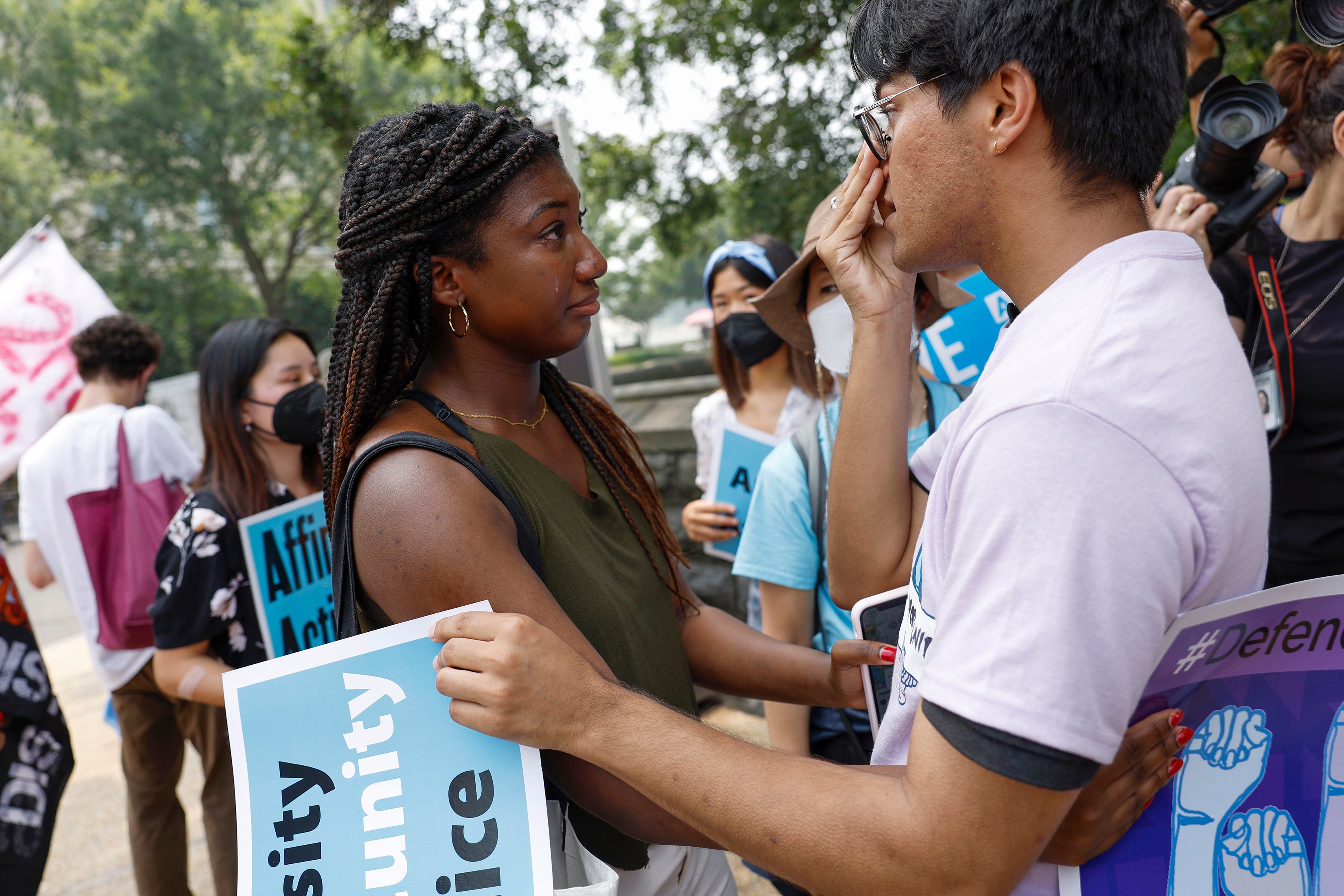
[ad_1]

The recent decision by the Supreme Court that race-conscious college and university admissions policies are unconstitutional has reversed decades of precedent. This decision, often conflated with the broader concept of affirmative action, will undoubtedly sow confusion and create a chilling effect on campuses. Colleges and universities, fearing further lawsuits, may curtail their actions beyond the minimum legal boundaries of the decision, while advocates of the ruling plead ignorance about the outcomes of their actions.
The Students for Fair Admissions cases against Harvard University and the University of North Carolina (UNC) are pieces of a larger movement to quell all discussion of racism across the country. These pieces exist in a patchwork quilt that includes Florida’s Stop WOKE Act, which tries to curtail discussions of racism and sexism at public colleges, Texas’s Senate Bill 17, which bans diversity, equity and inclusion efforts, and others. As a Texas-based professor of higher education policy who has previously worked in admissions, I have been keenly interested in following these maneuvers. Yet all college and university stakeholders should care, given that these developments could have drastic effects on the entire system of higher education in the U.S.
These legislative and legal actions in higher education join broader actions, such as the 2013 Supreme Court case that dismantled key portions of the Voting Rights Act, in describing a country that no longer needs interventions to combat white supremacy. Each presumes there is no need to implement purposeful policy to correct historical wrongs or to advocate for more equity because we have already accomplished our goals.
Nothing could be further from the truth. These actions uphold white supremacy in the U.S., dismantle policy advances that help to fight it and obscure the racialized reality of this country.
In the majority opinion in the admissions case, Chief Justice John Roberts argues for more “race-neutral” admissions practices, an odd descriptor for higher education policies in the U.S., given that structural racism has been the overarching organizational frame of our country and higher education is still overwhelmingly white. Justice Ketanji Brown Jackson, relying on the work of noted social scientists such as Ira Katznelson’s When Affirmative Action was White and Melvin L. Oliver and Thomas Shapiro’s Black Wealth/White Wealth, notes in her dissent that “[o]ur country has never been colorblind.” Since its inception, the state’s power has been used to redistribute resources based on racialized groups that were, in and of themselves, created by the state. As just one example, Jackson cites the Homestead Act of 1862, which was created to provide “free” acreage in the western territory of the country and actually stole Indigenous land while making it “exceedingly unlikely” for Black people to benefit.
This distortion of race neutrality is one of several Roberts uses in the court’s majority opinion and concurring justices use in theirs. It describes a U.S. that does not exist and has never existed.
The Court decided that institutions could not consider race overall but could take into account each individual applicant’s experiences with race. In the Chronicle of Higher Education, I noted that “[Chief Justice Roberts’s opinion] hammers in on the individual’s experiences with racism, but not the way that we have created our society and systems that support racism. How can you acknowledge that individual people experience racism without acknowledging that our systems are built to do this?”
But this contradiction is the point of the Court’s recent decision. Even though the SCOTUS decision explicitly states that institutions can use race when considering an individual’s experiences and that the decision only relates to admissions, we have seen (purported) confusion and questions abound: Can colleges consider race when awarding student financial aid? Can they consider it when hiring?
Similarly, even though there is an injunction that stops the Stop WOKE Act from being implemented at Florida’s public colleges, the Florida College System Council of Presidents released a statement affirming that “our institutions will not fund or support any institutional practice, policy, or academic requirement that compels … the idea that systems of oppression should be the primary lens through which teaching and learning are analyzed and/or improved upon.” This decision flies in the face of decades of research outlining the harms of promulgating and teaching racist practices, such as scientific racism.
Colleges are “conservative” with a small c. They move slowly and hate being the subject of litigation, even when there are no actors deliberately sowing confusion. This is part of the reason that I am concerned that institutions will overreact and curtail their practices beyond what the law explicitly requires.
It’s already happened. Liliana Garces of the University of Texas at Austin and her colleagues have found that legal pressures faced by educational can drive administrators to make less inclusive decisions for fear of reprisal and lawsuits when confronted with hate speech. That is why the Supreme Court’s actions are yet another square in the tapestry upholding white supremacy—making it so onerous for colleges to thread legal and legislative decisions that administrators overreact.
Along those lines, there’s already a new case being argued that focuses on a magnet high school from my home state, Virginia. The Fairfax County School Board was sued because of “race-neutral” changes in the school’s admissions policies (e.g., swapping an exam for essays and providing a preferential weight for students who are experiencing poverty). The plaintiffs argued the changes created an undue burden for students of Asian descent because they added weight to so-called proxies for race. Even though the appellate court ruled in favor of the school, it is widely expected that this case will be appealed to the Supreme Court, where even “race-neutral” admissions practices aimed at diversifying the student body may be curtailed. This gives away the game: the goal is not now, nor has it ever been, to solely focus on so-called race-neutral measures. It has been to dismantle any tools that can be used to advance racial justice in the U.S. —to neutralize any discussion of racism, the wages of whiteness and their joint effect on society.
The form of race-conscious admissions used at Harvard and UNC was one imperfect tool to advance racial justice. Even within that admissions regime, the reality was that we needed more redistribution of resources so that large public institutions, the institutions that educate the majority of college students in the U.S., would have better capacity to provide a strong education. We still do.
We need a world where a single athletic league in the Northeast (often referred to as the Ivy League) is not the primary arbiter of future stability, either in perception or in fact. But if we were only focusing on the imperfections of one admissions tool, we would miss the way that the recent Supreme Court decision, in conjunction with other changes around the country, creates a clear attack on our ability to fight white supremacy. It took deliberate policy actions over centuries for the U.S. to arrive at this point. It would be foolish for us to imagine that it would not require large-scale, long-term interventions to undo that damage.
This is an opinion and analysis article, and the views expressed by the author or authors are not necessarily those of Scientific American.
[ad_2]